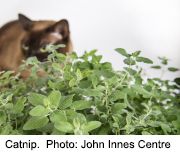
Rolling around, meowing and generally acting blissed-out: cats love the plant known as catnip. Now, British scientists say they’re closer to knowing how catnip works — and their insights might end up helping felines’ two-legged friends.
The substance in catnip that intoxicates cats is nepetalactone, explained a team led by Benjamin Lichman of the John Innes Center in Norwich, England. It’s emitted by microscopic glands on the underside of the catnip plant’s leaves.
“We have made significant progress in understanding how catnip makes nepetalactones, the chemicals that send cats crazy,” he said. These chemicals are part of a family called terpenes, and in plants, terpenes are typically formed by a single enzyme.
But Lichman’s group found that in catnip, terpenes are formed in a two-step process involving three newly identified enzymes. It’s the first time this two-step process has been observed, and it could have implications for medical science for humans.
“Catnip is performing unusual and unique chemical processes, and we plan to use these to help us create useful compounds that can be used in treatment of diseases such as cancer,” Lichman said in an Innes Centre news release.
That’s because similar chemical reactions occur in the creation of powerful cancer drugs like vincristine and vinblastine, which originate in plants such as Madagascar periwinkle, olive and snapdragon.
The study could help scientists recreate the way that plants produce these chemotherapy drugs, leading to faster and more efficient production of these medicines than is currently possible through harvesting them from nature, the researchers said.
And, in the meantime, “we are also working to understand the evolution of catnip to understand how it came to produce the cat-active chemicals,” Lichman said.

